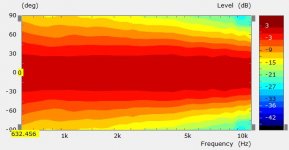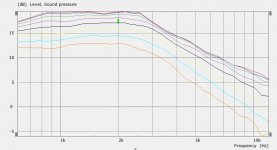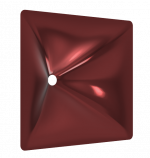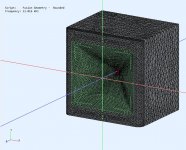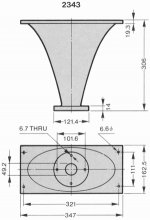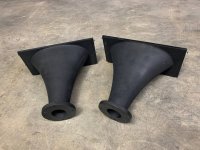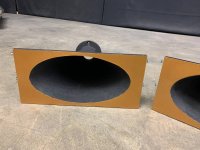Fusion is free for personal use, non commercial. They will disable your account after 365 days, but it can be renewed. So far it has worked for me, i've done one renewal for me and another for a friend
Have any of these M2-like designs been modeled with ATH/ABEC? Are they really much of advancement?
Most of the ones with pronounced knuckles are not that great but with enough time and effort in Ath they can be made pretty good.
This is my best effort at something M2 size and shape simulated in a cabinet in freespace.
Freestanding axisymmetric with a rollback can be made better in every way though.
This is my best effort at something M2 size and shape simulated in a cabinet in freespace.
Freestanding axisymmetric with a rollback can be made better in every way though.
Attachments
JBL 2343 horn possible to 3D print?
Would it be possible to design this horn in some 3D software and then print it?
I do not have 3D printer yet, just curious if it would even be possible? Could it be made as two halves that could be glued together?
Would it be possible to design this horn in some 3D software and then print it?
I do not have 3D printer yet, just curious if it would even be possible? Could it be made as two halves that could be glued together?
Attachments
This would be a relatively easy print on a 300x300 mm bed printer (cutting the front flange might be necessary) . I would still print in two parts due to the flanges, cut somewhere around the mid plane between flanges.
If you can figure a way to get Rhino, the student price is $195, that would be well worth it.
Can do amazing things with that software…
Also, if you have abs filament printed parts, they can be carefully treated with MEK solvent to get a smoother finish. That also seems to add a bit of strength as well.
Can do amazing things with that software…
Also, if you have abs filament printed parts, they can be carefully treated with MEK solvent to get a smoother finish. That also seems to add a bit of strength as well.
I'm still using 123D to do everything. It was free when it was released, but support for it died about five years ago.
You can't find it for download from the authors any longer, but there are some semi-sketchy sites where you can still get it. I downloaded it from amazon.com but the link is dead now. I keep a copy on an external USB for whenever I need to re-install it.
You can't find it for download from the authors any longer, but there are some semi-sketchy sites where you can still get it. I downloaded it from amazon.com but the link is dead now. I keep a copy on an external USB for whenever I need to re-install it.
I found one on: 123D Design (free) download Windows version
Would you be afraid to use it?
Would you be afraid to use it?
Last edited:
As noted in post #67, I am still using 123D for all my work, and it's working fine for me. I know that most have moved on to Fusion, but I personally found 123D to "get the job done." Basically I don't want to be bothered to learn something new.
The only significant flaws that I am aware of, in 123D are:
1) You have to force stop the program when you're done. Basically the program tries to make a network call to the cloud service when you close, and the cloud service isn't there... so you gotta force kill it.
2) 123D was and is kinda buggy. Not that the designs don't work, but particularly when you're subtracting objects it will sometimes crash, especially if they're complex. I am in the habit of saving my work frequently.
With that said...
The md5sum on the executable that I am personally using is 55edca8af560264c7893f2c4c398fba3
And the md5sum of the download here is identical: Downloading Autodesk 123D Design 2.2.14 (64-bit) from FileHorse.com
For all intents and purposes, this is the same program that was offered by Autodesk years ago. Just appears to be hosted by somebody else.
If you download the executable named "123D_Design_R2.2_WIN64_2.2.14.exe" and it has an md5sum of 55edca8af560264c7893f2c4c398fba3, you've got the original / unmodified program.
This web site also indicates that it should pass a virus check and the file is digitally signed by Autodesk:
123D_Design_R2.2_WIN64_2.2.14.exe55edca8af560264c7893f2c4c398fba3😀etailed Files Info
The only significant flaws that I am aware of, in 123D are:
1) You have to force stop the program when you're done. Basically the program tries to make a network call to the cloud service when you close, and the cloud service isn't there... so you gotta force kill it.
2) 123D was and is kinda buggy. Not that the designs don't work, but particularly when you're subtracting objects it will sometimes crash, especially if they're complex. I am in the habit of saving my work frequently.
With that said...
The md5sum on the executable that I am personally using is 55edca8af560264c7893f2c4c398fba3
And the md5sum of the download here is identical: Downloading Autodesk 123D Design 2.2.14 (64-bit) from FileHorse.com
For all intents and purposes, this is the same program that was offered by Autodesk years ago. Just appears to be hosted by somebody else.
If you download the executable named "123D_Design_R2.2_WIN64_2.2.14.exe" and it has an md5sum of 55edca8af560264c7893f2c4c398fba3, you've got the original / unmodified program.
This web site also indicates that it should pass a virus check and the file is digitally signed by Autodesk:
123D_Design_R2.2_WIN64_2.2.14.exe55edca8af560264c7893f2c4c398fba3😀etailed Files Info
Is there a service for making a 3D file that I can print/could I pay someone (with lots of experience) to make this file for me? (post#64)
(I assume it is quite a learning curve to design a 3D file for something like the JBL 2343 considering I am a total beginner)
(I assume it is quite a learning curve to design a 3D file for something like the JBL 2343 considering I am a total beginner)
If you had more details about that horn, it is relatively easy to make - I guess it is exponential expansion morphing from a circle to an ellipse. To make it from the sketch only would involve some guesswork and measuring some dimensions from the picture.
Is there a service for making a 3D file that I can print/could I pay someone (with lots of experience) to make this file for me? (post#64)
(I assume it is quite a learning curve to design a 3D file for something like the JBL 2343 considering I am a total beginner)
Instructions are in the 2nd post of this thread:
3D Modeling Tips and Tricks
Making the horn would take less than a minute.
The time consuming part of making printable horns and waveguides is where it mounts to the baffle and the compression driver. Basically making sure that the mounting holes line up with the compression driver.
3D printer
Thanks for the link to the instruction!
Today I ordered a Snapmaker 2.0 Modular 3D Printer F350. It has a printing volume of 320x350x330 mm. Delivery December 20.
I am guessing/hoping I will be able print the whole JBL 2343 horn in one piece on that printer?
Which type of filament should I order? How much/is there a way of calculating how much filament is needed? I am guessing the horn walls are approx 5 mm thick.
The mounts are maybe 8mm?
Thanks for the link to the instruction!
Today I ordered a Snapmaker 2.0 Modular 3D Printer F350. It has a printing volume of 320x350x330 mm. Delivery December 20.
I am guessing/hoping I will be able print the whole JBL 2343 horn in one piece on that printer?
Which type of filament should I order? How much/is there a way of calculating how much filament is needed? I am guessing the horn walls are approx 5 mm thick.
The mounts are maybe 8mm?
Last edited:
Instructions are in the 2nd post of this thread:
The time consuming part of making printable horns and waveguides is where it mounts to the baffle and the compression driver. Basically making sure that the mounting holes line up with the compression driver.
Could I start by printing the big surface and adjust the holes until they line up in the right places, and I stop the print and "turn the model upside down" is some way and adjust the holes on round side until they line up.
Not until the holes match o both ends do I turn the model so that the rectangular surface is down and start printing. This way I am hoping I can avoid to waste a lot of filament.
Would this theory work IRL?
Last edited:
I’ve never heard of re-indexing parts in a printer before, I would think for starters that the adhesion would be compromised since the part will have cooled, even if the part could be correctly positioned using a fixture.
Why can’t the holes be accurately measured?
Why can’t the holes be accurately measured?
I would split the horn perpendicular to the axis in ca 1/3 or just below the top flange, print it separately ang glue with CA glue afterwards - due to the overhangs. Once you have the 3D model, the slicer software, which produces the gcode for printing will calculate the amount needed. To start with, PLA is great and easy for beginners. PETG needs some skills knowing what to tune for a great print and can take more temperature before it gets soft. PLA is fine for home use amd for prototyping.
I should have mentioned that I will finish the horn in Wrinkle Paint that needs to be heated to 60 or 80 degrees Celsius to get the wrinkle effect. The horn has to be quite rugged. Can PLA withstand those temperatures?
PLA has a Glass Transition Temperature of about 55 to 60 deg C, so it will start to soften above that. PETG is 85. But the higher temperature filaments can be harder to print and often need to be very dry.
I have no experience with heated paints on prints, but PLA will not do it. PETG maybe. There is a material, rPET, which you can buy at ekomb.cz, which is strong and durable, but not so easy for printing, it needs even higher temperatures than PETG and at least 0.6 mm nozzle. The overall mechanical strength will depend on print settings - in general, more perimeters and infill, higher temperature and no cooling fan produce stronger prints. For maximum strength, you need to print some test objects and make destructive tests. For example, my PLA prints with 5 perimeters and 30 % infill are very strong and require goid amount of force to do any damage. Also, you can make the walls thicker, add ribs, etc.
- Home
- Loudspeakers
- Multi-Way
- 3D Modeling Tips and Tricks
